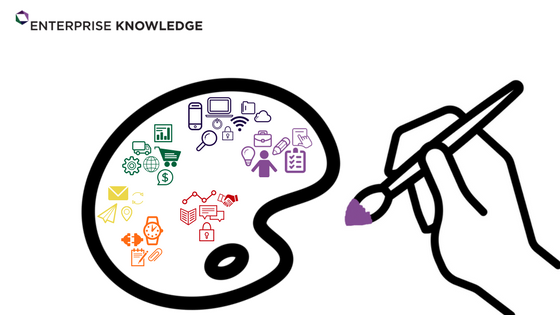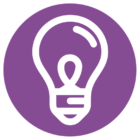
In my experience I’ve found that any successful taxonomy design effort stems from a strong understanding of the end users’ needs – hardly a small task. One way that I’ve worked to address this challenge is by incorporating Design Thinking into our taxonomy design process.
IDEO defines Design Thinking as a human-centered approach to problem solving that brings together the needs of people, technology, and business to solve complex problems with innovative solutions. The process is broken into phases, which can all occur in parallel and be repeated iteratively. This blog outlines how we at EK integrate each phase during a taxonomy design.
Why Design Thinking? Here at EK, we’ve seen countless instances where taxonomy design efforts suffer from a lack of buy-in and alignment, resulting in stagnation because users aren’t adopting and using the taxonomy. This methodology addresses those issues because it provides opportunities to fully understand users and their needs, and make sure that you’re truly designing for them. Using this approach ensures that a taxonomy design is one that users support and one that combines findability with usability.
 Empathize
Empathize
To start, you need to achieve an in-depth understanding of the problem that needs to be solved and remove any assumptions you may possess. This involves empathizing with users by observing and interacting with them to understand their experiences and motives. We’ve found this is often lacking in taxonomy design initiatives, where project stakeholders aren’t aligned on goals, or do not clearly understand the “why” of a taxonomy.
There are many approaches that you can take in order to accomplish this goal. At EK, we conduct interviews and focus groups, and facilitate taxonomy workshops. Interviews and focus groups can help you learn what your end users struggle with when it comes to finding and discovering information. Be conscious of who you’re interviewing and what types of questions you’re asking. Are you interviewing a range of users, representing different levels of experience and different areas of expertise? Are you asking leading questions based on what you assume the problem(s) to be?
Workshops in particular are incredibly valuable because they provide the opportunity to involve actual business users in the initial design phases, mitigating the risk of incorrectly presuming design requirements. While interviews and focus groups arguably offer the same benefits, workshop participants can additionally become your strongest advocates for a taxonomy design, as they are truly involved from the very beginning. In addition to interviews, focus groups, and workshops, consider collaboratively developing personas and empathy maps to identify user differentiators and key user needs. Together, these tools will help you draw key insights from your end users.
 Define
Define
The Define stage involves analyzing and synthesizing all of the previously gathered information to define the core problem(s) affecting your end users. In this phase, you’ll need to clearly define all of the users’ needs.
At EK, rather than focusing on creating a problem statement, we shift the focus to creating an outcome statement. In short, we’re asking the end users to answer the question, “What will this taxonomy allow end users to do/accomplish?” Asking this type of question allows us to easily capture the expectations and desires of the end users and make sure that we’re delivering a product that works for them. Just like creating an effective problem statement, creating this outcome statement simultaneously focuses your end users on the specific needs and creates a sense of possibility that allows team members to bounce off ideas in the Ideation stage.
 Ideate
Ideate
Armed with your user insights and clear problem/outcome statements, you can progress to the Ideate phase to identify alternatives to viewing the problem and subsequently, new solutions.
Here is where you may begin to move towards initial metadata field and value identification and prioritization, keeping in mind the aforementioned outcome statement. While it’s important to preface this phase with criteria regarding characteristics of successful business taxonomies, it’s also important to get a range of potential ideas and make sure everything is at least captured. The resulting set of metadata fields and corresponding values can give a high-level overview of the important content characteristics which may need to be reflected in the taxonomy.
 Prototype and Test
Prototype and Test
The Prototype phase offers the opportunity to test your potential solutions through inexpensive, scaled-down versions of the product or specific features. The final Test phase involves rigorous testing of the complete product. Taxonomy on paper tends to be abstract. Our prototyping and testing approaches bring real business context to the taxonomy design effort for our end users.
The metadata fields that are identified in the Ideate phase can help form a “starter taxonomy” that will be further tested and elaborated in order to become a truly effective business taxonomy. One way we tackle this phase at EK is through card sorting, a technique to discover how end users categorize information, which in turn helps to validate portions of a taxonomy design. The exercise can also help identify which categories need adjustments based on user feedback.
By the end of the prototyping stage, the team will have a clearer idea of the limitations of the taxonomy, the problems that exist, and a better understanding of how real users would act, think, and feel when interacting with the end product. In taxonomy design, testing of the complete product is ongoing, with alterations and refinements being considered and made through taxonomy governance to better reflect the end users and their evolving needs.
Conclusion
Progress in your taxonomy design effort starts with a clear understanding of your end users. That’s why Design Thinking can be incredibly helpful when building a taxonomy that will meet the real needs of your organization and your end users. This iterative, flexible, and collaborative methodology allows you to quickly identify, build, and test your way to success.
Want to learn more about incorporating Design Thinking into your next taxonomy design or refresh? Contact us at info@enterprise-knowledge.com.
